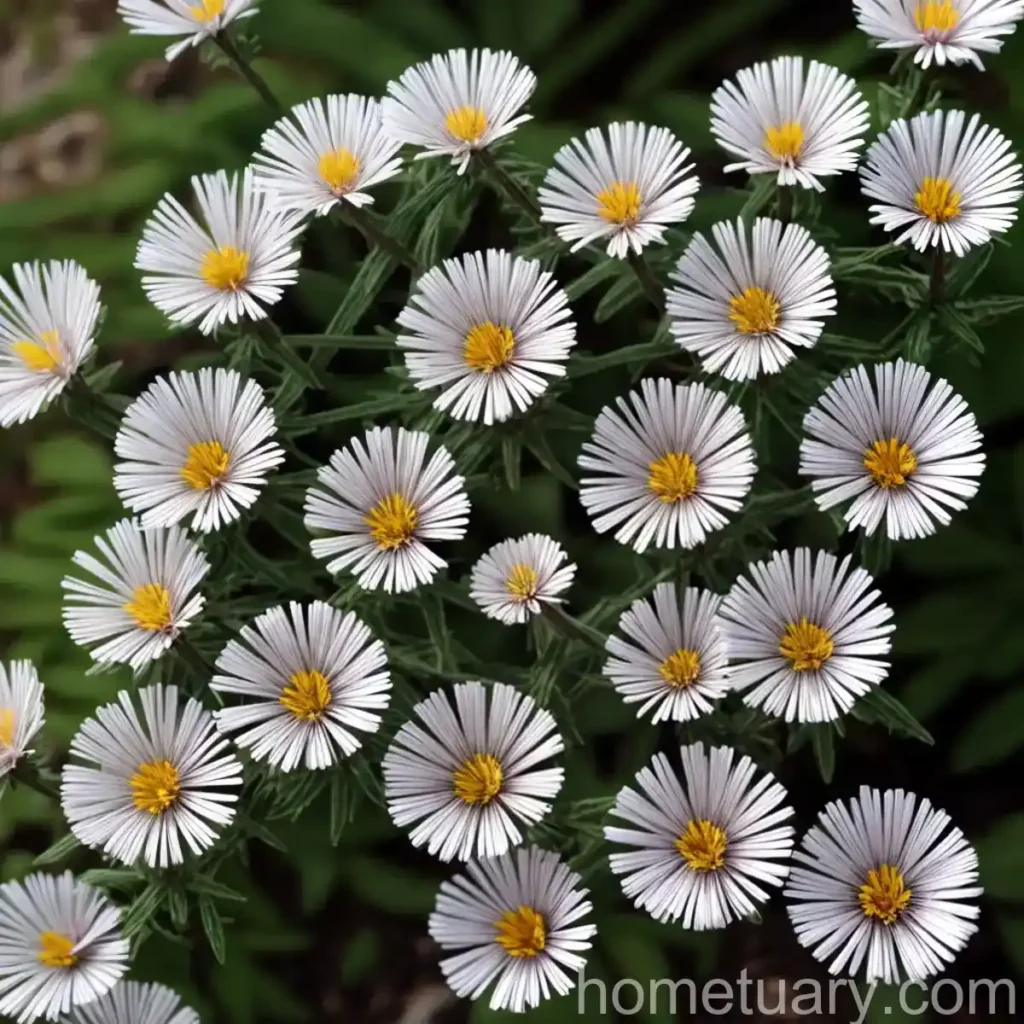Plant Profile: aster (Eurybia paludosa)
Aster (Eurybia paludosa) is a delightful perennial plant that belongs to the Asteraceae family, and it is commonly known as marsh aster. This beautiful wildflower adds a touch of elegance to any garden or landscape design with its charming blooms and ornamental foliage. In this comprehensive guide, we will explore the various aspects of caring for aster (Eurybia paludosa), including its cultural requirements, uses, propagation, common diseases, and much more.
What is aster (Eurybia paludosa)?
Aster (Eurybia paludosa) is a species of flowering plant native to North America, where it is commonly found in wetlands, marshes, and along the edges of streams and ponds. It is a herbaceous perennial that typically grows to a height of 1 to 2 feet, with slender stems and small, daisy-like flowers that bloom in late summer to fall. The foliage of aster (Eurybia paludosa) is also quite attractive, with narrow, lance-shaped leaves that add texture and visual interest to the plant.
Key Takeaways – aster (Eurybia paludosa)
- Botanical Name: Eurybia paludosa
- Common Name: Marsh aster, swamp aster
- Family: Asteraceae
- Plant Type: Herbaceous perennial
- Native Habitat: North America
- Height: 1 to 2 feet
- Bloom Time: Late summer to fall
- Special Features: Ornamental foliage, wildlife attractor
Now that we have a brief overview of what aster (Eurybia paludosa) is, let’s delve into the various aspects of its care and cultivation.
Culture
Cultivating aster (Eurybia paludosa) requires an understanding of its specific cultural requirements to ensure optimal growth and blooming. Here are some key cultural considerations for this enchanting wildflower:
Uses
Aster (Eurybia paludosa) has several uses in garden and landscape settings, making it a versatile and valuable addition to any outdoor space. Some common uses of this plant include:
- Wildflower meadows
- Rain gardens
- Cottage gardens
- Naturalizing along water features
- Providing habitat for pollinators and other wildlife
Water
As a plant native to wetlands and marshy areas, aster (Eurybia paludosa) has a preference for consistently moist soil. While it can tolerate occasional periods of drought, it thrives in soil that is evenly moist but well-draining. When establishing aster (Eurybia paludosa) in the garden, it is essential to provide regular watering, especially during dry spells, to support healthy growth and prolific blooming.
Sunlight
In terms of sun exposure, aster (Eurybia paludosa) performs best in partial to full sun. Providing at least 6 hours of sunlight per day can promote robust growth and abundant flowering. However, in warmer climates, some afternoon shade may be beneficial to prevent the plant from wilting during the hottest part of the day.
Fertilizer
Aster (Eurybia paludosa) generally does not require heavy fertilization, especially when grown in naturalized or wild garden settings. However, if the soil is particularly poor or if the plants show signs of nutrient deficiency, a balanced, slow-release fertilizer can be applied in early spring as new growth emerges. Avoid over-fertilizing, as this can lead to excessive foliage at the expense of flowers.
Soil
The ideal soil for aster (Eurybia paludosa) is rich, loamy, and slightly acidic, with good moisture-retention properties. It should be well-draining to prevent waterlogging, as excessively saturated soil can lead to root rot and other issues. Organic matter, such as compost or well-rotted manure, can be incorporated into the soil at planting time to improve its structure and fertility.
Pruning
Regular pruning is not typically necessary for aster (Eurybia paludosa), especially when it is grown in naturalistic settings. However, deadheading spent flowers can prolong the blooming period and prevent the plant from self-seeding excessively. Additionally, cutting back the stems to the base in late fall can help tidy up the plant and prepare it for the following growing season.
Propagation
Propagating aster (Eurybia paludosa) can be achieved through several methods, including division, seed sowing, and stem cuttings. Here’s an overview of each propagation method:
Division
Dividing mature aster (Eurybia paludosa) plants every few years is an excellent way to rejuvenate them and create new specimens. This is typically done in early spring or early fall when the plant is not in active growth. The clumps can be carefully dug up, and the root masses can be separated into individual sections, each with several shoots and a healthy root system. These divisions can then be replanted in prepared soil and watered thoroughly.
Seed Sowing
Collecting and sowing aster (Eurybia paludosa) seeds is another method of propagation. The seeds can be gathered from the plant after the flowers have faded and the seedheads have formed. Sow the seeds in trays or pots filled with a well-draining seed starting mix, and keep them consistently moist until germination occurs. Once the seedlings have developed several sets of true leaves, they can be transplanted into individual pots and grown on until they are large enough to be planted in the garden.
Stem Cuttings
Taking stem cuttings from healthy, non-flowering shoots of aster (Eurybia paludosa) is a reliable way to propagate this plant. The cuttings should be taken in late spring or early summer and inserted into a moistened rooting medium, such as perlite or vermiculite. Providing bottom heat and high humidity can encourage quicker root formation. Once the cuttings have established roots, they can be potted up into individual containers and grown on until they are ready to be planted out in the garden.
Container Popularity
Aster (Eurybia paludosa) is well-suited for growing in containers, especially if the garden has limited space or if specific growing conditions need to be met. When growing aster (Eurybia paludosa) in containers, consider the following tips for success:
- Choose a sizable container with adequate drainage holes to prevent waterlogging.
- Use a high-quality potting mix that provides good aeration and drainage.
- Place the container in a location that receives sufficient sunlight, as aster (Eurybia paludosa) generally performs best in partial to full sun.
- Water the plant regularly, ensuring that the soil remains consistently moist but not waterlogged.
- Fertilize the plant sparingly, using a balanced, water-soluble fertilizer at half-strength during the growing season.
- Monitor the plant for signs of stress, such as wilting or decreased flowering, and adjust its care as needed.
Common Diseases
While aster (Eurybia paludosa) is a relatively low-maintenance plant, it can be susceptible to certain diseases, particularly those related to moisture and humidity. Some common diseases that may affect aster (Eurybia paludosa) include:
- Powdery Mildew: This fungal disease presents as a white, powdery coating on the leaves and stems, often caused by high humidity and poor air circulation. To prevent powdery mildew, ensure proper spacing between plants and provide good air movement around the foliage. Fungicidal sprays can also be used as a preventive measure.
- Root Rot: Overly wet or poorly-draining soil can lead to root rot, where the roots become waterlogged and begin to decay. To prevent root rot, ensure that the soil has adequate drainage, and avoid overwatering the plant.
Prompt diagnosis and prompt implementation of appropriate measures can help control these diseases and prevent them from spreading to other plants in the garden.
Disease Diagnosis
When diagnosing diseases in aster (Eurybia paludosa), careful observation is key to identifying the issue accurately. Look for specific symptoms such as:
- White, powdery spots on the foliage (indicative of powdery mildew)
- Yellowing or browning of the leaves, especially at the base (possible signs of root rot)
- Wilting, stunted growth, or overall decline in plant health
It is essential to act swiftly upon noticing any unusual symptoms, as early intervention is crucial in managing plant diseases effectively.
Common Pests
While aster (Eurybia paludosa) is generally resistant to most pests, it can occasionally be troubled by certain insect visitors. Some common pests that may affect this plant include:
- Aphids: These small, soft-bodied insects can cluster on the new growth of aster (Eurybia paludosa) and excrete a sticky substance known as honeydew. Regularly inspect the plant for aphids, and use a strong blast of water or insecticidal soap to control infestations.
- Spider Mites: These tiny arachnids can cause stippling and webbing on the underside of the leaves. Spider mites thrive in hot, dry conditions, so maintaining adequate humidity and moisture levels can help deter their presence.
Regular monitoring of the plant and prompt action against pests can help keep aster (Eurybia paludosa) healthy and thriving.
Botanist’s Tips
Here are some additional botanist’s tips for successfully growing and caring for aster (Eurybia paludosa):
- Deadheading: Regularly remove spent flowers to encourage continuous blooming and prevent self-seeding in certain garden settings.
- Mulching: Apply a layer of organic mulch around the base of the plant to help retain soil moisture, suppress weed growth, and moderate soil temperature.
- Companion Planting: Pair aster (Eurybia paludosa) with other moisture-loving plants, such as lobelia, cardinal flower (Lobelia cardinalis), and turtlehead (Chelone spp.), to create a visually appealing and ecologically beneficial garden habitat.
By incorporating these tips into your care regimen, you can support the health and vibrancy of aster (Eurybia paludosa) in your garden.
Fun Facts
To further appreciate the beauty and ecological significance of aster (Eurybia paludosa), here are some fun and intriguing facts about this remarkable plant:
- Wildlife Attraction: Aster (Eurybia paludosa) attracts a variety of pollinators, including bees, butterflies, and hoverflies, making it a valuable addition to wildlife-friendly gardens.
- Native Habitat: In its natural habitat, aster (Eurybia paludosa) plays a vital role in the ecological balance of wetlands, providing food and habitat for a diverse array of native species.
- Medicinal Uses: Some indigenous communities have used aster (Eurybia paludosa) and related species for traditional medicinal purposes, harnessing its natural properties for various ailments.
Learning about the diverse roles and attributes of aster (Eurybia paludosa) adds depth to the appreciation of this captivating plant.
Links to External Resources
For further information on aster (Eurybia paludosa), its cultivation, and ecological significance, consider exploring these reputable external resources:
- Wildflower Center – Eurybia paludosa
- Missouri Botanical Garden – Eurybia paludosa
- USDA Plants Database – Eurybia paludosa
These resources can provide in-depth insights and a broader perspective on aster (Eurybia paludosa) and its role within natural ecosystems.
In conclusion, aster (Eurybia paludosa) embodies both aesthetic appeal and ecological value, making it a cherished component of wild gardens, naturalized landscapes, and habitat restoration projects. By understanding and embracing its cultural needs, uses, propagation methods, and potential challenges, gardeners can cultivate and appreciate this captivating wildflower to the fullest. Whether adorning rain gardens or enhancing native plant collections, aster (Eurybia paludosa) stands as a testament to the splendor of North American flora and the intricate tapestry of the natural world.
Remember that aster (Eurybia paludosa) not only adds beauty to the landscape but also supports local ecosystems, making it a valuable and meaningful addition to any garden.
By incorporating the guidance and insights provided in this guide, you can embark on a journey to nurture and celebrate the captivating presence of aster (Eurybia paludosa) in your garden and community.















